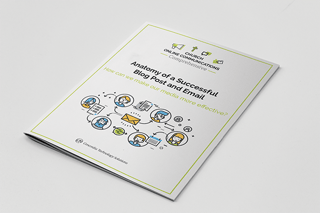
A couple weeks ago, we talked about how a content framework consists of a home base (your website), a media empire (blogs and emails), and outposts (social media). This week, our focus will be on the media empire, which is the source of all your church’s long-form communication.
Though your media empire may reside on your church’s website, it serves a very different purpose. The purpose of your website should be to encourage people to visit and get involved at your church; the media empire should direct people further into your website. In this blog post, we’ll delve into blogs and emails and learn how they can develop your church’s content framework.
Your Church’s Blog: More Than Just Opinions
For many individuals, a blog is a place to share personal thoughts and opinions on a periodic basis. But there are many other ways to use blogs—ways that can be more effective for churches.
For our purposes, let’s define a blog as an online feed that is regularly updated and is sorted chronologically with the newest information first. This definition allows your blog’s content and purpose to be flexible, but it keeps your blog timely and relevant. You can even have multiple blogs for your church, each with a different purpose and audience.
Many churches traditionally have a print media empire that consists of the newsletter or the bulletin, but these are losing popularity among laity. Nowadays, you can have video, audio, and so many other types of content beyond text! So while you can use your blog as a platform for the pastor sharing a theological perspective on current events, consider some of these options as well.
- Upcoming Events
Event information is timely, relevant, and constantly changing, so members may return to the blog often to check on it. - Prayer Requests
While prayer requests are often found in church bulletins, they are rarely found online because of privacy concerns. But here’s a way to safely share this information on your blog: post it in a private feed that readers need a username and password to access. - Bible Study Notes
Sharing the notes or downloadable handouts from Bible study will not only keep your members in the Word, but it will also allow people who can’t attend class to be part of the community of believers. - Sermons
Providing sermon texts or videos allows members to review each sermon if they would like to return to the message during the week. It’s also a great resource for potential visitors who want to get a feel for your church’s theology. - Requests for Assistance
Regularly posting needs for volunteers and donations can expose these requests to a wider audience. This also gives generous members a single place to search for opportunities to help out.
Of course, there are so many other types of content you can post; these are just a few to help you get started.
Email: Media You Send Directly to People
While your church’s blog(s) should be the primary destination for visitors to find the most timely information about your church, email is a powerful tool for distributing content directly to your audience.
Emails put the control into the hands of the recipients. Unlike social media, emails can be viewed at the recipients’ leisure and the recipient list is usually not visible, which puts less pressure on people to respond. Though email has developed a reputation for being spammy and invasive, it can be a very effective way of reaching your audience when it is used well.
Here are three types of emails you can use as part of your communication strategy.
- Newsletter Emails
The goal of a newsletter email is to provide a large amount of information in the same format on a consistent basis. You build habits, so your members start to trust what they will get and when they will get it. Rather than listing the details of everything in the email, consider linking to relevant blog posts on your website to start driving people deeper into it. - Single-Purpose Emails
A single-purpose email isn’t regular like a newsletter. It is sent out on its own with one message and one call to action. If too many of these emails are sent, people will start to ignore them. But when used sparingly, they can be very successful. - Segmented Single-Purpose Emails
These are single-purpose emails that are just sent to a smaller, more targeted list of people. These emails can actually be easier to create because they don’t have a one-size-fits-all approach. And more importantly, recipients feel like you wrote the email just for them—so these emails tend to be very effective.
One last thing about emails. The CAN-SPAM Act (Controlling the Assault of Non-Solicited Pornography And Marketing) is a current law designed to protect consumers from unwanted and inappropriate email messages. While the goal of this act is to primarily regulate businesses, churches should still follow these guidelines for the sake of their audiences. In other words, every good email follows CAN-SPAM regulations.
Emails and blogs are just the start—your church’s media empire can include any channels your audience is active in. So once you master these first two, you’re well on your way to having a great communication strategy.

What Makes a Good Post or Email?
Download this week’s free PDF, Anatomy of a Successful Blog Post and Email. You’ll learn all the right ingredients for building content for your church’s media empire.
Free Training Course
This blog post was part of the training series Church Online Communications Comprehensive. All the course materials are available online for free, and you can move through the course at your own pace. Start working toward an effective online communications strategy for your church today!
About the Author
Follow on Linkedin More Content by Peter Frank
























